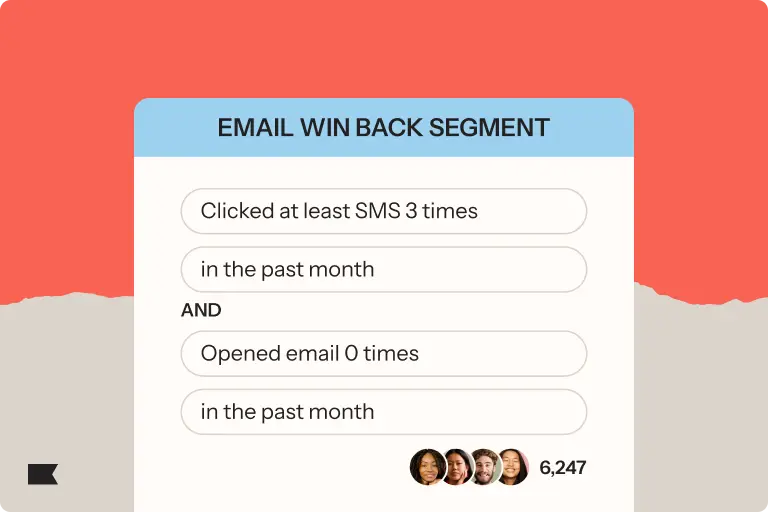Email marketing campaign success starts with these 10 essential components
Inboxes are more cluttered than ever.
But even with all the email newsletters, account updates, spam, and, yes, even messages from friends or colleagues, the truth is, we still check them. The best email marketing campaigns are the ones that are able to cut through the noise of the average inbox.
Even with so many other digital channels available today, email marketing remains one of the most effective tools for engaging customers and driving sales. In fact, email is a top-performing marketing channel: 76.86% of all businesses place email marketing in the top 3 ROI-generating marketing channels over channels like paid social and SEO.
But running a successful email marketing campaign is no cakewalk. From benchmarking email marketing costs and good email open rates to resonating with your target audience, there’s a lot to keep top of mind.
In this article, we walk you through 10 email marketing components of a successful campaign, plus the costs associated with email marketing and answers to a few of the most common email marketing campaign questions.
10 email marketing components for a successful campaign
1. Audience-first segmentation for more relevant content
According to Klaviyo’s 2025 future of consumer marketing report, 74% of consumers expect personalized experiences from brands. Segmentation is how you can meet this expectation.
Audience segments are smaller portions of your overall subscriber list that are grouped based on behavioral, psychographic, or demographic characteristics. The best email marketing campaigns use segmentation over blasting an entire email list with the same message, because it’s often not as effective as tailoring a message for a specific subset of your audience.
You can segment your audience based on:
- Behavior: products purchased, purchase frequency, money spent, product page visits, email engagement, etc.
- Psychographics: interests, lifestyle, values, beliefs, etc.
- Demographics: location, age, income, etc.
As a best practice, tailor offers to each audience segment. Here’s a great example from Tracksmith. To reward customer loyalty, the athletic apparel brand gives customers who renew their membership a special spike bag free of charge.

Source: Klaviyo Showcase
Email marketing campaign tip: When running a loyalty campaign, remember to exclude subscribers who have already taken action from subsequent campaign email follow-ups.
2. A relevant, value-packed offer for each audience segment
Remember, our inboxes are overflowing, so it’s safe to say your email offer needs to be one people can’t refuse. Here are some ways you can map an offer to an audience segment for relevance, which can help you come up with better email marketing campaign ideas, too.
Loyal customers → referral exchange
Tap in to a win-win situation by rewarding your most loyal customers for referrals. Check out this imaginative campaign from Recess, a hemp brand that can’t advertise on social media due to regulations. Here, they ask their most loyal Instagram followers via email to post on their behalf.

Source: ReallyGoodEmails
Product page visitors → customized product offers
Tailor offers to heavy product browsers by sending personalized product recommendations with a compelling incentive to buy.
New subscriber → contest or giveaway
Stoke new subscriber excitement, anticipation, and potential revenue by giving them the opportunity to enter a contest, giveaway, or sweepstakes with your brand.
Lifestyle/interest → limited-time discounts
Save money by tailoring time-limited discounts to lifestyle and interest preferences rather than spending your budget on blanket promotions. With proper testing, you’ll see where the budget for discounts is effective and where it’s wasted.
3. Enticing subject lines that create a curiosity gap
Email subject lines are one of the most important parts of your campaigns. A good email subject line is the reason most people open it to read what’s inside, so it’s important to get it right.
Important note: Apple’s privacy changes impacted the reliability of using open rates as a benchmark—meaning your open rates might seem high, but only because Apple’s own process counts as an open. But your email open rate can still be a directionally helpful metric, as long as you’re tracking it in conjunction with other metrics and not over-relying on it to tell the story of your email performance.)
Similar to your offer, tailor your subject lines to your audience. But keep them brief while piquing curiosity—and maybe creating some urgency.
Email marketing campaign tip: If you’re in marketing, you may be familiar with the term “curiosity gap”—the “space between the information we’re given (what we know) and the information that’s initially withheld (what we don’t know).” This is why it’s good to keep your email subject line brief—because the less information you give up front, the more your audience will want to close that gap for themselves.
Check out this example from sparkling water brand Aura Bora, which piques email subscribers’ interest with a subject line that reads, “everyone’s going bananas.” And yes, the email is actually about bananas (and bergamot).

Source: ReallyGoodEmails
4. Tone-optimized email copy that captivates attention
Like your offer and subject line, the best email marketing campaign copy should always reflect how your audience speaks. If you don’t know your audience, you’re not ready to write copy for them. But if you feel you know them well, then you’re in a good place to tailor your email campaign copy to their interests, lifestyle, and position in the customer journey.
Check out this Cyber Monday email from TUSHY, a bidet brand known for its sense of humor, which uses a pun to grab attention. It’s a great example of how to write tone-optimized copy that engages an audience.

Source: Deal Town
5. Compelling, helpful content
On top of hitting the right tone, your campaign content should be just as relevant and compelling as your core offer. Your content should generally fall into one of these categories:
Teach the reader something interesting.
Amuse, delight, and captivate your subscribers.
Encourage the reader to interact with your brand or take action in some way.
No matter which path you choose, the recipient should walk away from your email campaign with a clear understanding of the benefits of your offer.
6. A thoughtfully designed email layout
Sometimes the best email marketing campaign ideas start with design. A well-designed email can enhance readability and engagement, and draw attention to key messages and calls to action (CTAs) through the use of colors, fonts, and images—all of which can increase the likelihood of clicks and conversions.
Check out this example from Jones Road Beauty, which uses a clean email design to educate readers on how to apply their foundation for different skin types—and guide them to a large button to shop now.

Source: Klaviyo email template
7. A clear call to action (CTA)
CTAs are an essential email marketing component for generating revenue. Whether you want your readers to submit feedback, consume a piece of content, or make a purchase, CTAs are designed to grab the reader’s attention and encourage them to interact with the contents of the email.
One of the best ways to improve click rates on email CTAs is to create urgency. This example from kitchenware brand Made In demonstrates how a great CTA—“Shop the Sale”—can complement and reinforce visuals and body copy. There’s only one button, and the only other in-text link goes to the same “Shop the Sale” page.

Source: ReallyGoodEmails
Email marketing campaign tip: When it comes to email CTAs, less is more. “Don’t have more than 3 CTAs in your email,” advises Alexa Maltzer, vice president, client strategy at Power Digital. “Not only does this tend to make the email very long—and, therefore, harder to digest—it also increases the likelihood of users actually not clicking anything at all.”
8. Personalization based on event data
Event data includes any actions a specific subscriber or customer took to engage with your brand—and you can use it to further personalize your emails.
For example, you can insert dynamic messaging into your email copy that changes based on a customer’s lifetime value (CLV). For high CLVs, you can offer a unique promo code. For low CLVs, you can forgo the discount. This is how dynamic messaging paired with event data can make your campaigns more cost-efficient.
For these highly personalized campaigns, KPIs to consider measuring (beyond the usual metrics like email deliverability, unsubscribes, and bounce rates) are conversion rates and engagement rates for each dynamic messaging campaign.
Beekman 1802, a health and beauty brand, used Klaviyo’s Peel integration to build audience segments based on purchase frequency—like frequent shoppers, lapsed one-time buyers, and new subscribers who had never bought before.
Then they launched campaigns with tailored messaging for each segment by comparing campaign performance by segment across multiple sends. All of this contributed to 49% YoY growth in total BFCM ecommerce revenue in 2023.
9. Predictive analytics and AI-powered segmentation
One of the biggest challenges of smart segmentation is the time-consuming process of collecting and preparing your customer data. With AI-powered segmentation tools like Klaviyo Segments AI, you can simply describe the customers you want to reach and AI will create a segment for you.
Beyond segmentation based on audience behavior and other characteristics, some marketing automation platforms use AI to segment campaigns even further. Klaviyo, for example, applies a combination of data science and machine learning techniques to the data in your account to generate useful and actionable insights about your customers.
Here’s an example of a contact’s profile in Klaviyo, which shows predictive analytics like churn risk and predicted date of next order:

Source: Klaviyo
Klaviyo also automatically builds a CLV model using your company’s data—and retrains the model at least once a week. CLV refers to the total amount of purchases a customer makes over the course of their relationship with your brand—and in Klaviyo, you can segment based on historic CLV, predicted CLV, or total CLV, which combines the two. CLV segments group customers based on this amount so that you can send them relevant content and trigger segment-based flows.
For example, you can use historic CLV to build a VIP welcome flow, or use predicted CLV to send targeted campaigns to customers who will likely spend a certain amount over the course of a year.
When The Willow Tree Boutique, an apparel and accessories brand, started sending campaigns to customers whose AI-predicted next purchase date was in the last or next 30 days, the campaigns did so well that the team kept experimenting. They ran one campaign promoting pricier apparel to segments with demonstrated spending power—customers with a predicted CLV over $500, or an average order value over $150.
In just their first 6 months using Klaviyo’s predictive analytics, The Willow Tree Boutique saw 53.1% HoH growth in revenue.
10. SMS to support an omnichannel approach
To complement and add to your email marketing campaigns, you may also want to start engaging with certain audiences via SMS.
There are many ways to do this. You could lead a promotion with SMS by offering exclusive early access to SMS subscribers (generally this is best about a week or two before a sale). To increase urgency even more, you could give your SMS subscribers a 24-hour head start—and no more—with an early access link to shop before everyone else.
You can combine email and SMS to drive engagement after a sale has started, too. Send a reminder email to SMS subscribers who haven’t converted yet at the 24-hour mark. Then send a “last chance” SMS 48 hours after the sale has started to get the attention of subscribers who still haven’t purchased.
You can also mix email and SMS to optimize costs. Lead with email, which has a lower cost per message (CPM) for highly anticipated sales. If sales and engagement are strong, consider a second email notification to take advantage of the low CPM. Use SMS as a last call—if two emails haven’t converted subscribers yet, use SMS to grab their attention.
How much does an email marketing campaign cost?
Email marketing campaign costs can vary depending on factors such as your provider, the number of campaigns you’re running, and the size of your email list. (If you don’t have one yet, learn how to start an email list.)
As an example of a ballpark range, let’s look at Klaviyo’s pricing. If you have 1,001–1,500 profiles (subscribers to your email list), you have 3 types of plans to choose from:
- Free: starts at 500 monthly email sends and 150 free monthly SMS/MMS credits
- Email, starting at $45/month: starts at 15,000 monthly email sends and 150 free monthly SMS/MMS credits
- Email and SMS, starting at $60/month: gives you everything in the email-only plan, plus 1,250 monthly SMS/MMS credits
Because Klaviyo sets you up for hyper-precise audience segmentation, each of your sends is targeted and personalized to each recipient—no batching and blasting necessary.
Create a successful email marketing campaign with Klaviyo
No matter what industry you’re in, crafting a successful email marketing campaign requires more than just knowing your email marketing costs and the average email click rates you have to beat.
A good campaign involves constant experimentation, from design and CTA copy to audience segments and personalized offers. With Klaviyo B2C CRM, the CRM built for B2C, you’ll be able to personalize your campaigns to customer interactions with your brand—because all the data you have about that customer, from marketing to customer service inquiries, will live in one place.
Email marketing campaign FAQs
What is the most effective email marketing campaign strategy?
The most effective email marketing campaign strategy is one that uses audience segmentation, personalization, and automation.
Audience segmentation divides your customer base into distinct groups based on behavior, preferences, and demographics. Personalization goes beyond just using a recipient’s name in your emails—it should include product recommendations and special offers tailored to their interactions with your brand. Automation is what can help you send email marketing campaigns at scale, without needing to manually create audience segments, copy, and design from scratch.
By combining these strategies, you can create more targeted and relevant email marketing campaigns that encourage customer loyalty and boost revenue.
How do I start an email marketing campaign?
To start an email marketing campaign, begin by building your email list with sign-up forms on your website. Use a customer data platform to centralize email addresses and the behavioral signals attached to those email addresses for all your subscribers.
Then, clearly define your audience. Segment your audience list into smaller groups based on their interests, purchase history, location, etc. This segmentation will make it easy for you to tailor messages to each group, instead of sending the same email marketing campaign to your entire audience.
Personalize your emails with copy, design, and offers that reflect past interactions or seasonal events, so each recipient feels the message speaks directly to them. Finally, measure your results with analytics such as click rate, conversion rate, revenue per recipient, open rate, etc.
How often should I send marketing emails?
Most B2C brands should start with 1–2 email campaigns per week. As you learn what resonates with your audience, build up to more frequent sends (e.g., daily or multiple times a week). Keep in mind that segmenting your list based on engagement and sending frequency will lead to more engaged subscribers potentially receiving daily or weekly emails.
How long should an email marketing campaign last?
The ideal length of an email marketing campaign depends on your goals, audience, and the type of message you’re sending. An email campaign’s full timeline can range over a few days, weeks, or even months, and it can also happen in stages.
For example, your Black Friday Cyber Monday campaign will have a main push over the actual BFCM weekend, but you may begin your full BFCM campaign well in advance of the weekend to meet your goals. Some seasonal campaigns like this can last for weeks when there are several teasers leading up to your main email campaign push.
Ultimately, the best approach is to tailor your campaign duration to your audience’s needs and your specific objectives, adjusting as you gather data and feedback.
What are common mistakes to avoid in email marketing campaigns?
A common mistake to avoid in email marketing campaigns includes sending generic messages to your entire list rather than segmenting your audience. This is a mistake because it can lead to lower engagement and conversion rates.
Another common mistake is to overlook the importance of personalizing your emails. You’ll need to make sure your customer data platform and email marketing platform are one in the same to avoid this mistake. When your data and automation are centralized, you’ll be able to use dynamic content blocks to personalize your campaigns to product preferences and past purchases.
A few other common mistakes include:
– Neglecting to set clear goals for your campaign. Emails without a clear goal often go overlooked in people’s inbox, because the content isn’t personalized or relevant.
– Including too many calls to action that can divert attention away from the main objective of your email campaign.
– Overlooking the importance of mobile optimization. Most people read emails on their phones and will quickly abandon messages that are hard to read or tap on.
Related content
- How to create an email campaign in 7 steps, with smart strategies, and real-life examples
- 10 email campaign optimization best practices to supercharge your emails
- Aura Bora boosts campaign frequency and grows Klaviyo revenue 59.5% YoY


Related content

Learn how to use Klaviyo SMS, segmentation, and hybrid flows to re-engage lapsed email subscribers, boost deliverability, and drive higher retention.

Boost D2C email revenue from 12% to 30% with the Klaviyo playbook: high-converting pop-ups, a 5-email welcome series, smart filters, and optimized abandonment flows.

Even though the BFCM season ended, there are still important precautions to take. Learn how to clean up your sender reputation at the beginning of December.